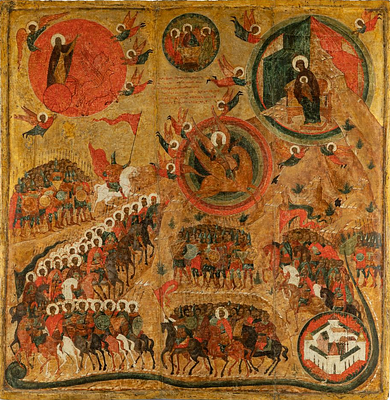Russian school, workshops of the Old Believers, first half of the 19th century. "Resurrection of Christ, Christ's Descent into Hell, and His Life in 1
Lot 18
About Seller
Setdart Auction House
Carrer Aragó 346
Barcelona
Spain
Setdart Subastas was born in 2004 and is currently the first online art auction in Spain with solidity, prestige and reliability guaranteed by our more than 60,000 users. Setdart has a young, dynamic and enterprising team ready to successfully manage the purchase and sale of art works through custom...Read more
Estimate:
EUR€3,000 - EUR€4,000
$3,125 - $4,166.67
Absentee vs Live bid
Two ways to bid:
- Leave a max absentee bid and the platform will bid on your behalf up to your maximum bid during the live auction.
- Bid live during the auction and your bids will be submitted real-time to the auctioneer.
Bid Increments
| Price | Bid Increment |
|---|---|
| EUR€0 | EUR€10 |
| EUR€200 | EUR€25 |
| EUR€500 | EUR€50 |
| EUR€1,000 | EUR€100 |
| EUR€3,000 | EUR€200 |
| EUR€5,000 | EUR€500 |
| EUR€10,000 | EUR€1,000 |
| EUR€20,000 | EUR€2,000 |
| EUR€50,000 | EUR€5,000 |
About Auction
By Setdart Auction House
Sep 23, 2021
Set Reminder
2021-09-23 10:00:00
2021-09-23 10:00:00
America/New_York
Bidsquare
Bidsquare : RUSSIAN ICONS
https://www.bidsquare.com/auctions/setdart-auction-house/russian-icons-7431
Setdart Auction House sofia@setdart.com
Setdart Auction House sofia@setdart.com
- Lot Description
Russian school, workshops of the Old Believers, first half of the 19th century. "Resurrection of Christ, Christ's Descent into Hell, and His Life in 16 hagiographic scenes". Tempera on panel. Measurements: 53 x 44 cm. Descent of Christ to hell is one of the most important representations in the Christian iconography. This passage was known in Ancient Rus since the 11th century, although it became most popular in the second half of the 14th century. Iconography of this New Testament passage finally developed in the 17th century in Moscow workshops. In this period, the icon reached its maximum complexity, combining the New and Old Testament passages, and at the same time composing the scenes of the Resurrection and Christ's descent into hell into one. The icon of interest, despite its relatively simple composition, a central register surrounded by 16 hagiographic scenes, is very attractive due to the symbolism of the symbolic details that accompany each of the miniatures. In the central scene, which forms the main theme of the icon, we can find representations of hell, very unusual in orthodox iconography, in the form of the open mouth of the monstrous dragon. The 16 miniatures are striking in their architectural and natural detail. These scenes should be viewed from the upper left-hand corner towards the right-hand corner, and then in the following order: the sixth image on the far left, the seventh on the far right, and onwards, culminating with the sixteenth cell in the lower right-hand corner. The entire composition ends with four evangelist apostles in each corner of the icon. This valuable piece belongs to the workshops of the Orthodox Old Believers, who were persecuted by the official church from the second half of the 17th century. A number of features point to this, including the inscriptions on the outer border, the blessing with two fingers, and the eight-pointed crosses.
- Shipping Info
-
In-house shipping available. Please inquire at admin@setdart.com.
-
- Buyer's Premium



 EUR
EUR CAD
CAD AUD
AUD GBP
GBP MXN
MXN HKD
HKD CNY
CNY MYR
MYR SEK
SEK SGD
SGD CHF
CHF THB
THB
















